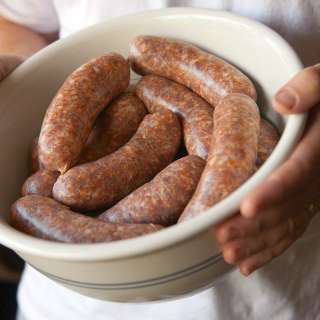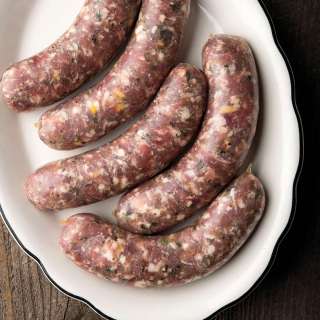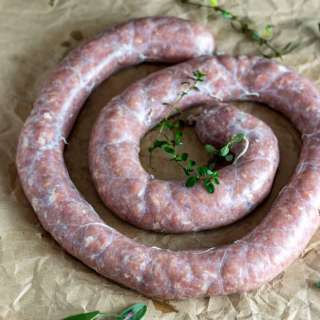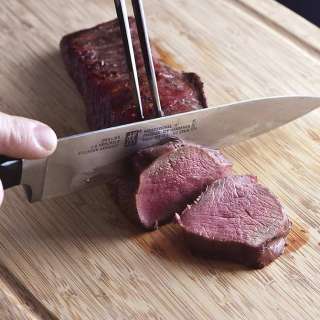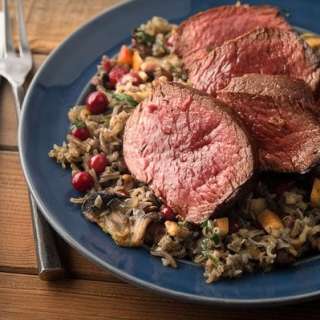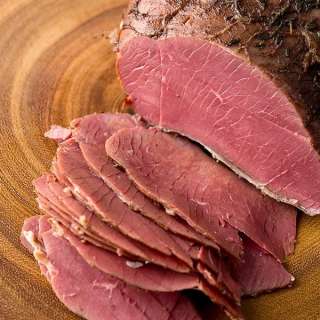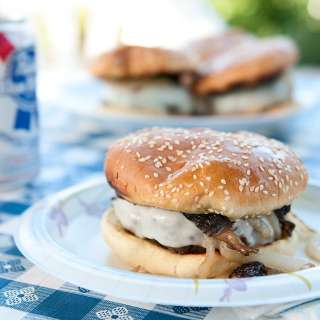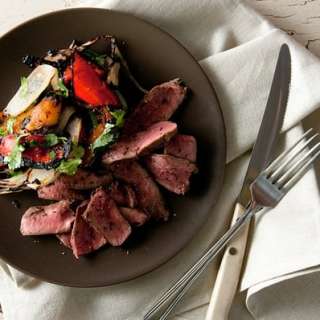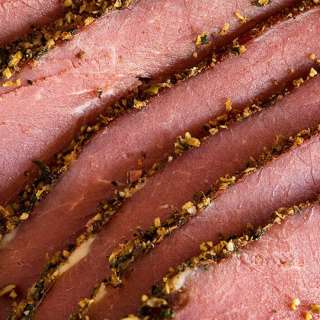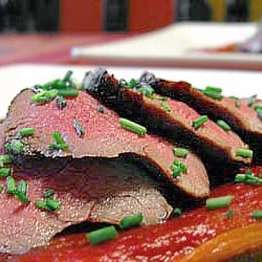
Venison Summer Sausage
User Reviews
5.0
27 reviews
Excellent
-
Prep Time
3 hrs
-
Smoking Time
4 hrs
-
Total Time
7 hrs
-
Servings
25 servings
-
Calories
168 kcal
-
Course
Main Course, Snacks

Venison Summer Sausage
Report
This is an old school variety of summer sausage that is fully cured. Many modern versions are not, and must be refrigerated or they will spoil quickly. This is more like a salami; if you want that softer summer sausage texture, hang for less time.
Share:
Ingredients
- 3 ½ pounds venison
- 1 pound fatty pork shoulder
- ½ pound pork fatback
- 51 grams salt
- 6 grams Instacure No. 2
- 10 grams dextrose, or granulated sugar if you can’t get it
- 1 tablespoon cracked black pepper
- 1 tablespoon coarsely ground coriander seed
- 2 teaspoons coarsely ground mustard seed
- 1 teaspoon powdered ginger
- ½ teaspoon ground cloves
- ¼ cup malt vinegar
- 1/2 cup Distilled Water
- 10 grams F-LC or FRM-52 starter culture
- Hog casings preferably 38-42 mm wide casings
Instructions
- Cut the meat and fat into chunks that will fit into your grinder. Trim as much sinew and silverskin as you can. Put the fat into a container in the fridge. Mix the dextrose, salt and curing salt with the meats and put it in the fridge overnight. This helps develop myosin, which will give you a tighter bind when you stuff the links later.
- The next day, put your grinding equipment — blade, coarse and fine die, etc. — in the freezer. Mix the ginger, cloves and half of the remaining spices with the meat and fat. Put the mixture into the freezer and let everything chill down until it hits about 30°F or so. It won’t freeze solid because of the salt. Normally, this takes about 90 minutes. While you’re waiting, soak about 15 feet of hog casings in a bowl of warm water, and put the malt vinegar in the fridge.
- When the meat and fat are cold, take them out and grind through the coarse die of the grinder; I use a 10 mm plate. Test the temperature of the mixture, and if it’s 35°F or colder, go ahead and grind it all again through a fine die, like a 4.5 mm. If it’s warmer than 35°F, put the mix back in the freezer to chill. This might take an hour or so if you’ve let the meat warm up too much. Use the time to clean up, and to dissolve your starter culture in the distilled water.
- Once the sausage has been ground twice, test the temperature again to make sure it’s 35°F or colder. I prefer to chill the mix down to 28°F to 32°F for this next stage. Chill the mix and when it’s cold enough, take it out and add the remaining spices, the vinegar and the water-starter culture mixture. Now, mix and knead this all up in a big bin or bowl with your (very clean) hands for a solid 2 minutes—your hands will ache with cold, which is good. You want everything to almost emulsify.
- Stuff the sausage into hog casings rather loosely. For this sausage, you want long links. First cut lengths of casing about 2 feet long. Stuff each with a little more than 1 foot's worth of sausage, leaving with plenty of extra casing on either side. Do this with all the sausage before moving on.
- When you’re ready, gently compress the long links. Keep an eye out for air pockets. Use a sterile needle or sausage pricker (set it aglow in your stovetop flame) to puncture the casing over all the air pockets. Gently compress the links together to squeeze out the air pockets; this takes practice. Tie the ends of the casing together in a double or triple knot.
- Hang the links from a clothes rack or somesuch. I use “S” rings you buy from the hardware store to hang them from the clothes rack rods. Now you need to ferment your links, keeping them warm and moist. I do this by putting a humidifier under the hanging sausages and then tenting the whole shebang with big garbage bags that I’ve sliced open on one end. I also use a water sprayer to spritz my sausages a couple times a day. Doing this prevents the casings from hardening. Keep your sausages hanging at room temperature (65 to 80°F) at about 85 percent humidity for three days.
- Move the sausages to your smoker and smoke them over very low heat for up to 4 hours of continuous smoke. It is vitally important that you do not cook your links here, so put ice in the water tray of the smoker and smoke on a cold day or in the early morning. Don’t let the smoker rise above 100°F at all. If it gets too hot, open the door of the smoker or just take the links out.
- Now you need to dry your sausages and turn them into salami. Hang them in a place that is about 50°F to 60°F with about 80 to 90 percent humidity. In most cases you will need to put a humidifier under your links. I also spritz them with water once a day for the first 2 weeks. After the first week of hanging, drop the humidity to 70 to 80 percent. On the third week drop it again to 65 to 70 percent and hold it there until a total of 4 to 8 weeks has elapsed since the salami went into the chamber.
- You now have boerenmetworst. To store long-term, vacuum seal them individually and keep in the fridge. They will last indefinitely this way, and the vacuum sealing will keep them from becoming rock hard. You can also freeze them.
Notes
- I generally make 1/2 pound to 1 pound sausages in this recipe, so you'll get somewhere between 5 and 10 links. Shoot for links about 1 foot long, more or less.
- Obviously to do this right you'll need a smoker and a place to ferment the links, and a place to hang them afterwards. Have all this ready before you begin. Tips on each of these are in the headnotes.
- Do not mess with the amounts of salt, cure or starter. Yes, I use more starter than strictly needed. I do this to ensure that you get enough in the sausage, so the good bacteria will defeat the bad bacteria. It is a food safety measure.
- You really do want the links kinda sweaty those first couple days. Not hot, but moist. This helps fermentation and prevents the links from drying out too soon.
- If you hang these sausages for only 3 to 4 weeks, you will get a consistency a little closer to the modern summer sausage. I don't love this, so I cure fully. It's a personal choice.
- The spices give you a very Dutch or German style sausage. You can vary things to get a different effect, or leave some of the spices out if you happen to have an aversion to one or another.
Nutrition Information
Show Details
Calories
168kcal
(8%)
Carbohydrates
1g
(0%)
Protein
17g
(34%)
Fat
10g
(15%)
Saturated Fat
4g
(20%)
Polyunsaturated Fat
1g
Monounsaturated Fat
5g
Cholesterol
67mg
(22%)
Sodium
833mg
(35%)
Potassium
254mg
(7%)
Fiber
1g
(4%)
Sugar
1g
(2%)
Vitamin A
8IU
(0%)
Vitamin C
1mg
(1%)
Calcium
8mg
(1%)
Iron
2mg
(11%)
Nutrition Facts
Serving: 25servings
Amount Per Serving
Calories 168 kcal
% Daily Value*
| Calories | 168kcal | 8% |
| Carbohydrates | 1g | 0% |
| Protein | 17g | 34% |
| Fat | 10g | 15% |
| Saturated Fat | 4g | 20% |
| Polyunsaturated Fat | 1g | 6% |
| Monounsaturated Fat | 5g | 25% |
| Cholesterol | 67mg | 22% |
| Sodium | 833mg | 35% |
| Potassium | 254mg | 5% |
| Fiber | 1g | 4% |
| Sugar | 1g | 2% |
| Vitamin A | 8IU | 0% |
| Vitamin C | 1mg | 1% |
| Calcium | 8mg | 1% |
| Iron | 2mg | 11% |
* Percent Daily Values are based on a 2,000 calorie diet.
Genuine Reviews
User Reviews
Overall Rating
5.0
27 reviews
Excellent
Other Recipes

